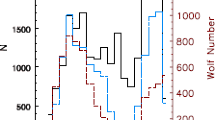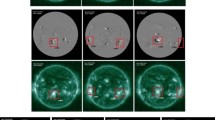Abstract
We study the phase relationships between the coronal-mass-ejection (CME) energy cycle, the sunspot-area cycle, and the flare-index cycle from 1996 to 2010. The results show the following: i) The activity cycle of the flare index significantly leads the activity cycle of the sunspot area. ii) The activity cycle of the CME energy is inferred to be almost in phase with the activity cycle of the sunspot area; the activity cycle of the CME energy at low latitudes slightly leads the activity cycle of the sunspot area; the CME energy at high latitudes is shown to significantly lag behind the sunspot area. iii) The CME energy is shown to significantly lag behind the flare index; the CME energy at low latitudes is shown to slightly lag behind the flare index; the CME energy at high latitudes is shown to significantly lag behind the flare index.





Similar content being viewed by others
References
Bachmann, K.T., White, O.R.: 1994, Solar Phys. 150, 347. ADS: 1994SoPh..150..347B . doi: 10.1007/BF00712896 .
Brueckner, G.E., Howard, R.A., Koomen, M.J., Korendyke, C.M., Michels, D.J., Moses, J.D., Socker, D.G., Dere, K.P., Lamy, P.L., Llebaria, A., Bout, M.V., Schwenn, R., Simnett, G.M., Bedford, D.K., Eyles, C.J.: 1995, Solar Phys. 162, 357. ADS: 1995SoPh..162..357B . doi: 10.1007/BF00733434 .
Chang, H.Y.: 2011, New Astron. 16, 456. ADS: 2011NewA...16..456C . doi: 10.1016/j.newast.2011.04.003 .
Cho, I.-H., Chang, H.-Y.: 2011, J. Astron. Space Sci. 28, 1. ADS: 2011JASS...28....1C . doi: 10.5140/JASS.2011.28.1.001 .
Deng, L.H., Li, B., Zheng, Y.F., Cheng, X.M.: 2013, New Astron. 23, 1. ADS: 2013NewA...23....1D . doi: 10.1016/j.newast.2013.01.004 .
Du, Z.L., Wang, H.N.: 2012, Res. Astron. Astrophys. 12, 400. ADS: 2012RAA....12..400D . doi: 10.1088/1674-4527/12/4/004 .
Gao, P.X., Li, K.J.: 2008, Chin. J. Astron. Astrophys. 8, 146. ADS: 2008ChJAA...8..146G . doi: 10.1088/1009-9271/8/2/02 .
Gao, P.X., Li, K.J., Shi, X.J.: 2009, Mon. Not. Roy. Astron. Soc. 400, 1383. ADS: 2009MNRAS.400.1383G . doi: 10.1111/j.1365-2966.2009.15534.x .
Gao, P.X., Li, K.J., Xu, J.C.: 2011, Solar Phys. 273, 117. ADS: 2011SoPh..273..117G . doi: 10.1007/s11207-011-9853-z .
Gao, P.X., Xie, J.L., Liang, H.F.: 2012, Res. Astron. Astrophys. 12, 322. ADS: 2012RAA....12..322G . doi: 10.1088/1674-4527/12/3/008 .
Gopalswamy, N., Shimojo, M., Lu, W., Yashiro, S., Shibasaki, K., Howard, R.A.: 2003a, Astrophys. J. 586, 562. ADS: 2003ApJ...586..562G . doi: 10.1086/367614 .
Gopalswamy, N., Lara, A., Yashiro, S., Howard, R.A.: 2003b, Astrophys. J. Lett. 598, L63. ADS: 2003ApJ...598L..63G . doi: 10.1086/380430 .
Hundhausen, A.J.: 1993, J. Geophys. Res. 98, 13177. ADS: 1993JGR....9813177H . doi: 10.1029/93JA00157 .
Kleczek, J.: 1952, Publ. Inst. Centr. Astron. 22.
Li, K.J., Irie, M., Wang, J.X., Xiong, S.Y., Yun, H.S., Liang, H.F., Zhan, L.S., Zhao, H.J.: 2002, Publ. Astron. Soc. Japan 54, 787. ADS: 2002PASJ...54..787L .
Li, K.J., Gao, P.X., Li, Q.X., Mu, J., Su, T.W.: 2009, Solar Phys. 257, 149. ADS: 2009SoPh..257..149L . doi: 10.1007/s11207-009-9333-x .
Özgüç, A., Ataç, T.: 2003, New Astron. 8, 745. ADS: 2003NewA....8..745O . doi: 10.1016/S1384-1076(03)00063-0 .
Özgüç, A., Ataç, T., Rybák, J.: 2003, Solar Phys. 214, 375. ADS: 2003SoPh..214..375O . doi: 10.1023/A:1024225802080 .
Özgüç, A., Ataç, T., Rybák, J.: 2004, Solar Phys. 223, 287. ADS: 2004SoPh..223..287O . doi: 10.1007/s11207-004-7304-9 .
Ramesh, K.B., Rohini, V.S.: 2008, Astrophys. J. Lett. 686, L41. ADS: 2008ApJ...686L..41R . doi: 10.1086/592774 .
Ramesh, K.B.: 2010, Astrophys. J. Lett. 712, L77. ADS: 2010ApJ...712L..77R . doi: 10.1088/2041-8205/712/1/L77 .
Sheeley, N.R. Jr.: 1991, Astrophys. J. 374, 386. ADS: 1991ApJ...374..386S . doi: 10.1086/170129 .
Temmer, M., Veronig, A., Hanslmeier, A.: 2003, Solar Phys. 215, 111. ADS: 2003SoPh..215..111T . doi: 10.1023/A:1024843010048 .
Ternullo, M.: 2007, Astron. Nachr. 328, 1023. ADS: 2007AN....328.1023T . doi: 10.1002/asna.200710868 .
Vourlidas, A., Subramanian, P., Dere, K.P., Howard, R.A.: 2000, Astrophys. J. 534, 456. ADS: 2000ApJ...534..456V . doi: 10.1086/308747 .
Vourlidas, A., Howard, R.A., Esfandiari, E., Patsourakos, S., Yashiro, S., Michalek, G.: 2010, Astrophys. J. 722, 1522. ADS: 2010ApJ...722.1522V . doi: 10.1088/0004-637X/722/2/1522 .
Vourlidas, A., Howard, R.A., Esfandiari, E., Patsourakos, S., Yashiro, S., Michalek, G.: 2011, Astrophys. J. 730, 59. ADS: 2011ApJ...730...59V . doi: 10.1088/0004-637X/730/1/59 .
Wang, J.X., Zhou, G.P., Wen, Y.Y., Zhang, Y.Z., Wang, H.N., Deng, Y.Y., Zhang, J., Harra, L.K.: 2006, Chin. J. Astron. Astrophys. 6, 247. ADS: 2006ChJAA...6..247W . doi: 10.1088/1009-9271/6/2/12 .
Wheatland, M.S., Litvinenko, Y.E.: 2001, Astrophys. J. 557, 332. ADS: 2001ApJ...557..332W . doi: 10.1086/321655 .
Yashiro, S., Gopalswamy, N., Michalek, G., St. Cyr, O.C., Plunkett, S.P., Rich, N.B., Howard, R.A.: 2004, J. Geophys. Res. 109, 07105. ADS: 2004JGRA..109.7105Y . doi: 10.1029/2003JA010282 .
Zhou, G.P., Wang, J.X., Zhang, J.: 2006, Astron. Astrophys. 445, 1133. ADS: 2006A&A...445.1133Z . doi: 10.1051/0004-6361:20053536 .
Acknowledgements
The authors thank the referee very much for their careful reading and constructive comments, which improved the original version of the manuscript. The authors are grateful to K.J. Li for his helpful discussions and A. Vourlidas for furnishing us with data and his helpful discussions. The SOHO/LASCO data used here are produced by a consortium of the Naval Research Laboratory (USA), Max-Planck-Institut für Aeronomie (Germany), Laboratoire d’Astronomie (France), and the University of Birmingham (UK). SOHO is a project of international cooperation between ESA and NASA. The LASCO/CME catalog is generated and maintained at the CDAW Data Center by NASA and The Catholic University of America in cooperation with the Naval Research Laboratory. The flare-index data used in this study were calculated by T. Ataç and A. Özgüç from Bogazici University’s Kandilli Observatory, Istanbul, Turkey. The sunspot-area data were complied by Royal Greenwich Observatory (RGO) and the Solar Optical Observing Network (SOON) of the US Air Force (USAF)/US National Oceanic and Atmospheric Administration (NOAA). This work is supported by the Natural Science Funds of China (11273057, 11221063, 11203068 and 11073010), the 973 programs 2011CB811406 and 2012CB957801, the Chinese Academy of Sciences, and the Foundation of Key Laboratory of Solar Activity of National Astronomical Observatories of Chinese Academy of Sciences (KLSA201302), and Key Laboratory of Dark Matter and Space Astronomy of Purple Mountain Observatory of Chinese Academy of Sciences (DMS2012KT008).
Author information
Authors and Affiliations
Corresponding author
Rights and permissions
About this article
Cite this article
Gao, P.X., Xie, J.L. & Zhong, J. Phase Relationships Between the CME-Energy Cycle, the Sunspot-Area Cycle and the Flare-Index Cycle. Sol Phys 289, 1831–1841 (2014). https://doi.org/10.1007/s11207-013-0409-2
Received:
Accepted:
Published:
Issue Date:
DOI: https://doi.org/10.1007/s11207-013-0409-2




